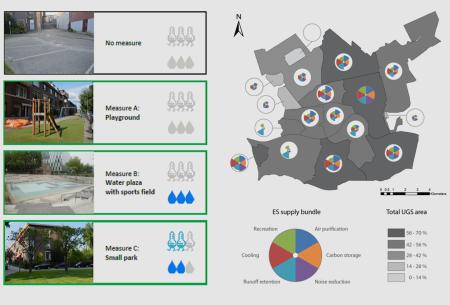
Resource description:
Methodology for assessing urban green infrastructure and planning for ecosystem services.
Author/Contact:
TURAS
Expert contact: Marthe Derkzen
Requirements:
- Urban Green Infrastructure can mitigate negative side-effects of urbanization such as noise, heat, and stormwater runoff, as well as provide space for recreational activities with positive effects on flora and fauna, and community interaction. The underst
Advantages:
- The methodology provided by this tool helps to map and quantify these so-called ecosystem services such as air purification, carbon storage, noise reduction, water retention, cooling, and recreation. It can be used to assess the ecosystem services provide
- In addition, the tool offers a method to gauge the acceptance of UGI design by local residents. This method includes the assessment of people’s awareness of urban heat and flooding, their problem perception, their perception of green space benefits, the
- Main types of outcome: physical improvements, process innovation, community empowerment, knowledge/data.
Constraints:
- Urban inhabitants are suffering from air pollution, noise, and urban heat island effect. These problems are affecting people’s lives daily, in the long-term, and their health. Urban Green Infrastructure (UGI) can ameliorate these problems and simultaneo
Uses of this resource:
The world is becoming increasingly urbanised. The concentration of buildings, commerce, traffic, and people in cities leads to soil sealing, heat, pollution, and biodiversity loss. In this context, climate change poses additional challenges to established and evolving cities, especially in terms of increasing urban flood risk and heat stress.
Additional information:
WHO SHOULD BE INVOLVED?
FACILITATORY (PUBLIC) BODIES:
planning and development department; land use planning department; green spaces department; water and sewerage management department; community development department; policy development department; environmental and sustainability department
LOCAL TASK FORCE:
community group; professional expert; researcher; local or regional authority
SUITABLE FOR:
dense inner city; urban region; (sub-)urban communities
MAIN NECESSARY RESOURCES ARE:
public institutional set-up; space; monetary investments; community trust; expert knowledge; legal legitimisation
Licence:
- Free, no licence
Development stage:
- Full, working product